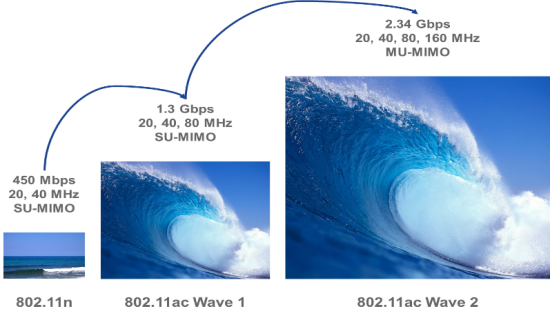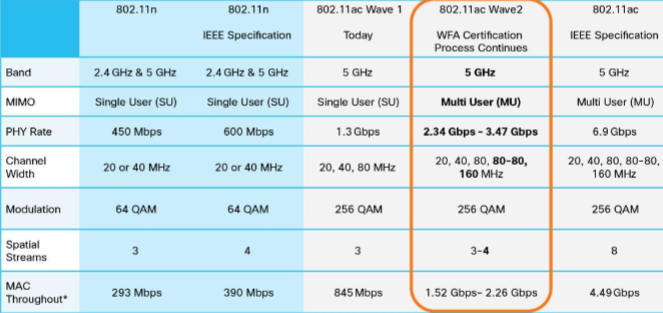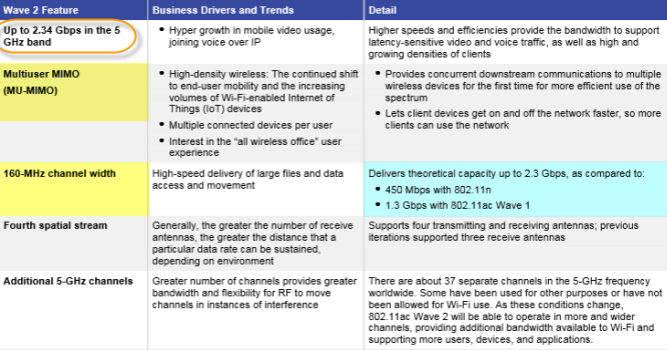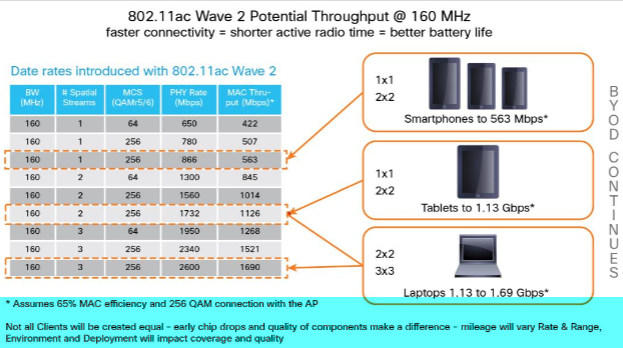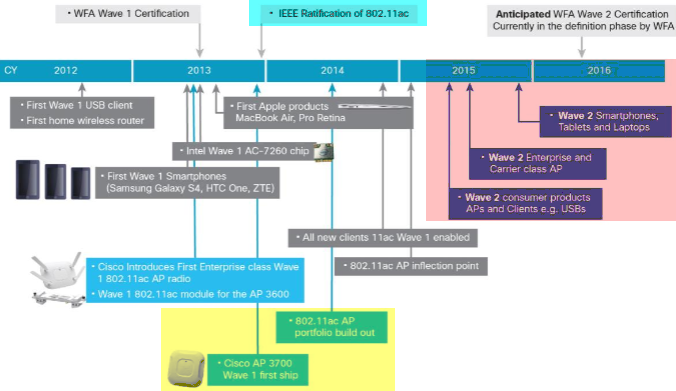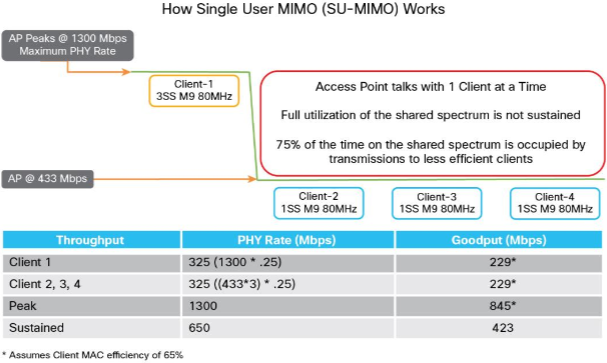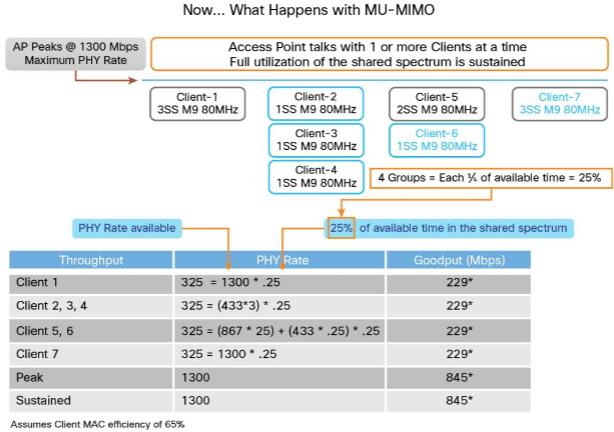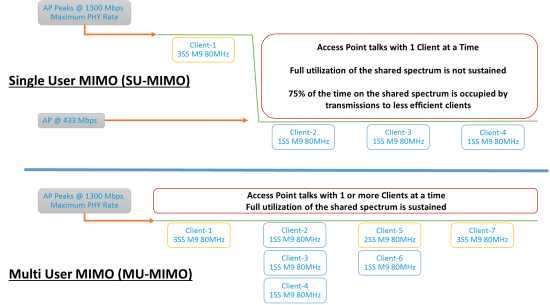
Using mobile devices for work is a big trend for modern workers. They look for business access from multiple locations using mobile devices such as smartphones, laptops, and tablets. For IT, this means delivering highly secure, reliable mobility to employees and guests.
We talked about the Cisco 802.11ac Solution, Migrating to Wave 2 and Wave 2 AP. In the With 802.11ac connections, organizations benefit from a reliable wireless network that supports a broad range of applications. Well, what’s the 802.11ac? Why is it so necessary today? In the following part we will talk to you about the Cisco 802.11ac Solution.
802.11ac, the successful predecessor of 802.11n, is a transformational wireless LAN technology that represents a significant performance increase over the previous one. The 802.11ac IEEE standard allows for theoretical speeds up to 6.9 Gbps in the 5-GHz band, or 11.5 times those of 802.11n. 802.11ac is coming to market in two releases: Wave 1 and Wave 2.
More Comparing 802.11ac Wave 2, Wave 1, and 802.11n
802.11ac Wave 2 as a Business Enabler is Becoming Necessary
802.11ac Wave 2 Potential Throughput
160 MHz channel width is added to the current support of 20, 40 and 80 MHz channel widths with Wave 1, providing a boost in performance up to 2.34 Gbps from 1.3 Gbps with Wave 1. Companies have the flexibility and option to manage the amount of available wireless spectrum deployed within their network as and when appropriate.
Why are there two 802.11ac “waves”? The 802.11ac IEEE standard is being introduced to the market in a series of “waves” (releases) of new products and technology. The reason is that the capabilities in 802.11ac are numerous, and delivering them in waves allows the industry to take advantage of many without having to wait for all capabilities to be available. The standard defines a framework that provides a significant step beyond 802.11n and allows for growth into the future.
Anticipated 802.11ac Wave 2 Deployment Timeline
Note that both consumer-class and enterprise-class products including features for Wave 2 will likely appear in the market before the Wi-Fi Alliance launches its certification program. Of course, any product launched into the market before certification may run the risk of noncompliance with interoperability between 802.11ac devices and clients. But Cisco is confident its access points will be certifiable by the Alliance once the certification program actually launches (expected in the middle to the second half of 2016).
Wave 1 hardware and Wave 2 hardware are not compatible with each other. 802.11ac Wave 1 required new hardware in both access points and client devices to deliver channel widths up to 80 MHz, 256 quadrature amplitude modulation (256-QAM), and up to three spatial streams. The result was a maximum data rate of 1.3 Gbps, or about three times the top-end 802.11n products in the market. Similarly, Wave 2, a superset of Wave 1, requires new hardware in both access points and client devices to support the additional 802.11ac capabilities such as MU-MIMO, channel widths up to 160 MHz, and the potential for a fourth spatial stream.
Will 802.11ac Wave 2 continue to support 802.11ac Wave 1 and other 5-GHz protocols? Yes, 802.11ac Wave 2 access points will interoperate with 802.11ac Wave 1, 802.11n, and 802.11a client devices. Support for all Wave 2 features, however, requires Wave 2 support in both the access point and in the client.
Multi-User MIMO (MU-MIMO) vs. Single-User MIMO (SU-MIMO)
MU-MIMO stands for multiuser multiple input, multiple output, and is a brand new feature introduced with 802.11ac Wave 2. Wave 2 MU-MIMO support is required on both the access point and client device to work. It operates in the downstream direction, access point to client, and allows an access point to transmit to multiple client devices simultaneously.
This differs from Wave 1 and previous single-user (SU)-MIMO 802.11 iterations, in which an access point transmits to a single client device at a time very quickly and efficiently.
SU-MIMO Operation
MU-MIMO Operation
MU-MIMO will share all of the available wireless spectrum across multiple client devices, thereby optimizing the efficiency of the wireless network while servicing more client devices. Contrast this with today’s SU-MIMO where the network services a single client at a time and based on the type of client the wireless spectrum can be fully utilized or a portion of the network left idle as a client is connected.
e.g. 1 Spatial Stream (SS) smartphone or tablet, or 2SS tablet or laptop rather than alternating up and down based on the type of individual client connected with the AP in a SU-MIMO environment.
There are more questions that are related to MIMO technology and MU-MIMO, Cisco Catalyst Multigigabit Switching technology based on the NBASE-T Alliance, Wave 2 access points, FCC’s 5-GHz Channel Plan, and European 5-GHz Channel Plan, etc. You can read more information from Cisco’s page: 802.11ac Solution-802.11ac Wave 2 FAQ
More Related
Why You Should Upgrade with Cisco 802.11ac Solution?
Migrating to Wave 2? …Definitely
NEW Cisco Aironet 1850 Series Access Points Focus on Wave 2 Wifi
The Time of Multigigabit, Cisco’ s New Campus LAN Switches
Cisco Aironet 802.11n G2 Series Indoor Access Point Comparison


